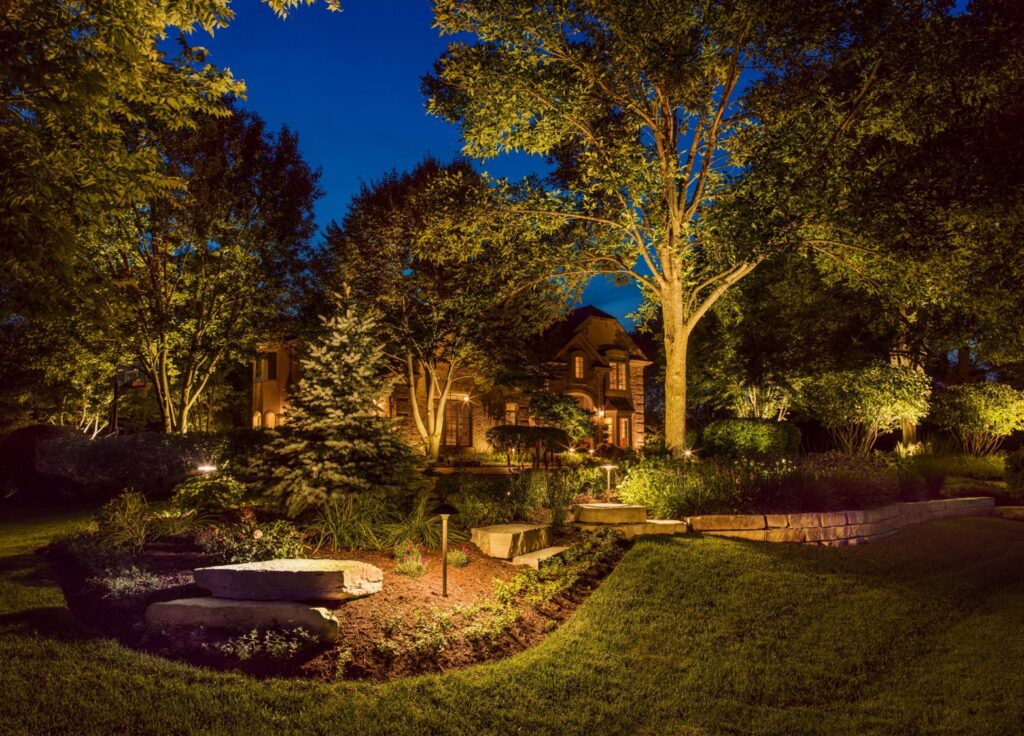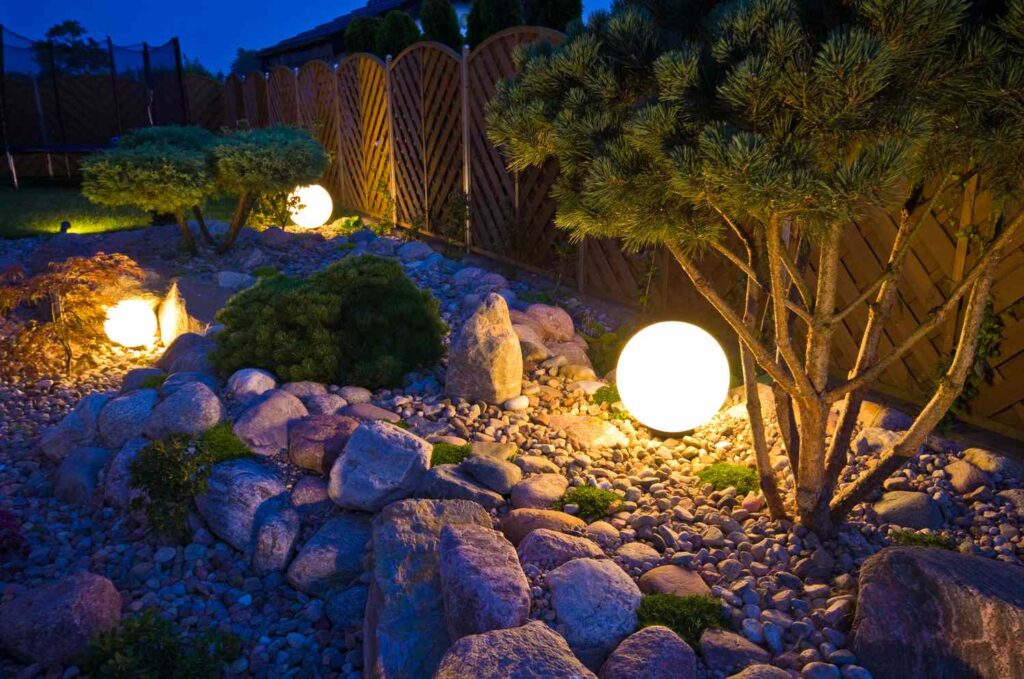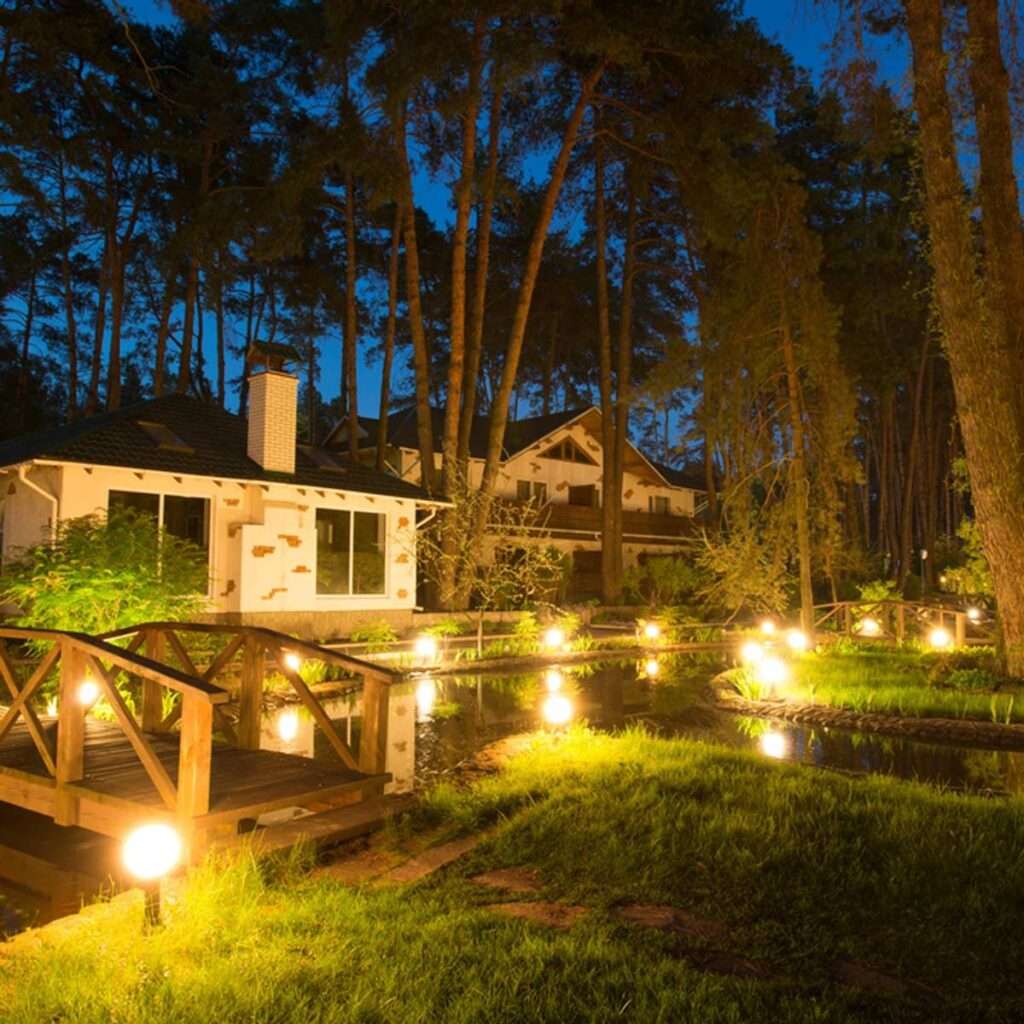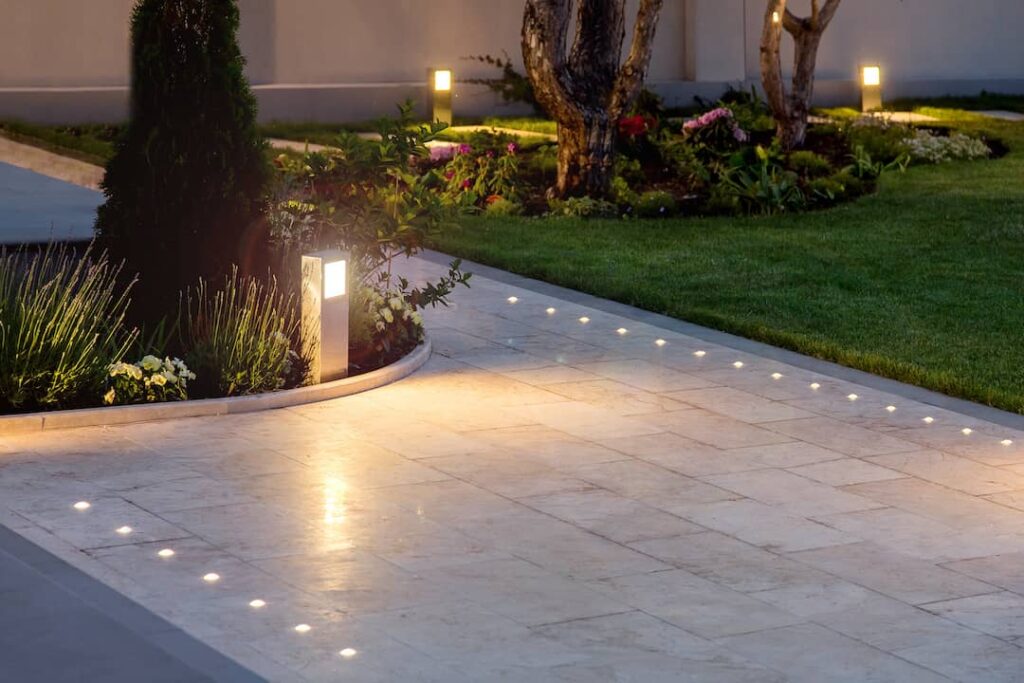Contact us for quotation
Let's have a chat
Let's have a chat
When you embark on a journey to illuminate the beauty of your yard during nightfall, the idea of landscape lighting comes into play. Lighting a landscape adds an air of sophistication to your property and significantly enhances its worth.

While aesthetically pleasing and functional, landscape lighting can be a substantial investment. This cost primarily originates from the quality and durability of the materials used, the intricacy of the design, and the labor-intensive installation process. Additionally, specific lighting techniques highlight the right spots in your yard and ensure a seamless blend of safety and aesthetics. All these aspects make landscape lighting a complex task, which justifies its high cost. In the upcoming sections, we’ll delve deeper into these factors to clarify why landscape lighting doesn’t come cheap.
Understanding landscape lighting is fundamental to discerning its cost. Similar to your indoor lighting setup, planning for landscape lighting requires careful consideration. It involves assessing the landscape’s size, elements, and other aspects. More than just lighting, it showcases the homeowner’s character, enhances the landscape’s features, and elevates the property’s overall appearance.
Lighting your landscape is not merely a matter of installing a large floodlight. Although such a setup might provide basic illumination, it isn’t truly landscape lighting. It would help if you thoughtfully chose among various types of lights, fixtures, and other elements to illuminate your landscape correctly.
A properly illuminated landscape enhances its usability and infuses it with your unique personality. It creates a lasting impression on all who visit your property.
Lighting a landscape might be costly and time-consuming, but the benefits outweigh the expenses when done correctly. Let’s explore some of the main advantages it brings.
Ask any interior designer, and they’ll attest to the significance of lighting in enhancing a space as much as its elements. While lackluster lighting can dull even the most premium features, well-planned lighting can enliven the simplest elements. This holds for landscape lighting. For instance, properly lighting tall trees within your garden can create a visual delight. Likewise, swimming pools or ponds can appear as if they’re from a movie scene with the right lighting.
In short, excellent landscape lighting draws in visitors, instilling a sense of envy for your property.
A well-lit landscape can boost the value of your property. Imagine visiting a home with a beautifully illuminated landscape where every feature is accentuated. Now compare it to another property with subpar landscape lighting. Which one would you be more inclined to purchase? The answer is obvious and proves the significant impact lighting can have on property value.
This is especially crucial for those planning to buy a property to later sell for profit. Besides minor repairs, investing in landscape lighting can significantly enhance the property’s value.
Have you ever left your indoor lights on while you step out, leaving the room well-lit? This is a common practice to deter burglars. Similarly, landscape lighting enhances your home’s Security. It keeps your surroundings well-lit, making it difficult for intruders to find hiding spots or access points. While Security might not be the primary function of landscape lighting, an added layer of protection is always beneficial.

With all its allure, landscape lighting carries a substantial price tag that might deter homeowners. Comprehending what contributes to this expense can help you navigate and uncover cost-effective solutions. Let’s delve into why landscape lighting tends to be costly.
The need for top-grade materials is a necessity in landscape lighting. Weather-resistant fixtures, wiring, and supports are crucial to endure temperature extremes and prevent early deterioration. Specialty materials designed for landscape lighting are available in the market. For instance, water and corrosion-resistant fixtures are a must.
The go-to material for landscape lighting fixtures is cast brass, prized for its lifelong warranty. This assurance of long-term durability relieves you of malfunctioning worries, yet this premium quality also contributes to the high cost.
Maintenance is a significant contributor to the overall expense of landscape lighting. It involves more than just swapping out burnt bulbs; it also includes regular wiring inspection, identifying possible damage, and checking support structures for rust or corrosion.
Given the vastness of landscapes compared to interiors, repair and replacement costs can escalate quickly. However, as mentioned earlier, investing in high-quality fixtures can cut down these recurring expenses.
As you’d hire an interior designer for your home’s interiors, landscape lighting also demands professional expertise. These professionals assess your landscape, advise on design possibilities and guide you in choosing cost-effective fixture options. While hiring a designer may appear costly initially, it can lead to substantial savings in the long run.
The journey from finalizing a design to its implementation is more complex than it appears. While you may manage without a designer, securing a safe and proper installation without a professional is challenging.
The complexity of landscape lighting wiring is best left to professionals to avoid hazards like electrocution. They ensure the wiring is safely concealed and protected against environmental factors. While professional installation may seem expensive, it significantly reduces maintenance costs and safety risks in the long run.
The landscape lighting market offers a variety of lights, including incandescent bulbs, halogen lights, and LEDs. While incandescent bulbs may seem attractive due to their low initial cost, they are less energy-efficient and durable. In the long run, this results in higher maintenance, replacement, and energy costs.
Conversely, LEDs require a higher initial investment but offer unparalleled energy efficiency and longevity. This means this may cost more upfront but ultimately save you more long-term than incandescent bulbs.
Landscape lighting is more than just buying fixtures. You’ll also need supporting structures, tightening equipment, and installation tools. These additional components can add up to your overall expense. Hiring professionals can somewhat alleviate these costs as they bring their tools.
Moreover, like the lights, these accessories must be robust enough to withstand harsh weather conditions. So, purchasing quality materials is vital for effective implementation.
Having unpacked the costs involved in landscape lighting, let’s explore some smart techniques that can trim your budget without compromising aesthetics.
As its title suggests, illuminating paths involves light to brighten walkways and other areas in the landscape, such as driveways, footpaths, and parking spaces. Multiple methods exist to achieve this type of lighting. Options include in-ground lights installed along the path’s sides or lanterns affixed to structures bordering the path.
The first method is cost-effective as it doesn’t necessitate additional structural support. However, the second option, though potentially more costly, lends an added elegance to the area.
Highlighting from below, or up-lighting, refers to the artistic application of lights under taller landscape features, such as trees. These lights counteract the objects’ shadows, emphasizing them and lending a touch of sophistication to the overall landscape aesthetic. Various fixtures, such as wall sconces and troffer units, can help achieve this effect.
Illuminating from above, or downlighting, acts as the counterpoint to up-lighting by directing light from above the structures. This technique can be employed on multiple landscape elements, including swimming pools and ponds, to create pleasing visual effects. Light fixtures like gooseneck, barn lights, task lights, and table lamps can be used for this purpose. Although the latter two aren’t typically used in landscapes, they can be an attractive addition to patio furniture.
As implied by its name, spotlighting is the method used to draw attention to specific structures within the landscape. This could involve accentuating prominent trees. These lights are available in various colors, providing opportunities to create contrasting ambiance in different parts of the landscape.
Light bathing, or washing, is achieved by positioning a spotlight at a particular angle to light up various objects. Generally, these lights are installed on shrubbery walls to emphasize them.
Imitating moonlight, or moonlighting, is a lighting technique that seeks to replicate the soft glow of natural moonlight. These subtle lights provide an appealing perspective and can be used around various structures in the landscape to cultivate a gentle, moonlit ambiance.
Embedded lighting, or in-grade lights, are installed within the ground and highlight the surrounding objects. Besides aesthetic enhancement, these lights increase the functionality of different areas. They can be used along paths and walking tracks within landscapes to improve safety.

Numerous lighting fixtures are available for creating the landscape designs we previously discussed. Let’s explore some of the most prevalent ones.
Installed to enhance the visibility of walkways within landscapes, path lights ensure a safe stroll without collisions or trips. This can be achieved through either in-ground lighting or the installation of petite lamp posts along the walkways. Although incandescent and halogen lights are options, LEDs stand out as the superior choice due to their energy efficiency and durability. Unlike cheaper, inferior incandescent alternatives, they don’t require frequent checking or replacement.
Primarily used on patios, deck lights serve both functional and aesthetic needs. They can be employed to illuminate various furniture items from multiple angles. Additionally, these lights can be fitted alongside staircases within homes or along railings leading to rooftops, enhancing the lighting of these outdoor areas.
Area lights are utilized to provide broad illumination, lighting up large spaces. While they are an effective solution for most landscapes, their primary function is useful, not decorative. To boost the landscape’s aesthetic appeal, you would need to incorporate other lighting fixtures alongside them.
Floodlights, similar to area lights, are substantial fixtures that cover extensive spaces. These lights cast a wide beam, covering a larger area and creating an ambient light effect. However, they are typically complemented with other fixtures to create a more decorative effect.
Spotlights are the opposite of floodlights, casting a focused, narrow beam that accentuates a specific feature or area. They can draw attention to a unique landscape feature or illuminate a tall tree. These lights usually play a more decorative role compared to their functional use.

Professional assistance for planning and establishing landscape lighting conditions is advisable if you possess a substantial property. Nevertheless, embarking on a do-it-yourself lighting project is feasible for smaller landscapes. To illuminate your landscape affordably, consider the following steps.
Launching into a landscape lighting task commences with visualizing a schematic of your lighting arrangement. Carefully examine your landscape and its constituents, mentally crafting a design sketch. You can confidently progress to the subsequent step with a clear vision of how each element should be illuminated.
Having settled on your design, it’s time to sift through the various options for executing it. As mentioned, typical choices encompass LEDs, Halogen, and incandescent bulbs. Our recommendation leans towards LEDs, not only for their cost-effectiveness but also for their versatility. Available in a wide variety of shapes, sizes, and hues, LEDs can facilitate the realization of your design vision effortlessly.
If you’ve opted for LED lights, acquiring superior quality is vital. In contrast to your interior lights, these lights will be exposed to harsh weather conditions, necessitating more robustness than regular LEDs. Ensure they’re outdoor-rated before selecting them for your landscape.
The most challenging aspect of installing landscape lights is the wiring process. It would help if you concealed the wiring to shield it from UV-ray-induced wear and tear. This requires investing in suitable wire and other protective components. However, you can sidestep this issue entirely with solar lights. These self-charging lights eliminate wiring, saving energy costs and simplifying the landscape lighting installation process.
When lighting your landscape, it’s crucial to maintain balance and refrain from over-illumination. A subtle approach helps avoid glare that could prove disruptive during lighting hours. Various anti-glare fixtures can help, though they tend to be costly. If you’re working within a limited budget, consider some DIY methods to mitigate glare from landscape lights.
While it’s undeniable that landscape lighting comes with a considerable price tag, its potential to boost the property’s value justifies the investment. The high cost is attributed primarily to the need for top-notch quality bulbs, wires, and other essential installation equipment. These materials must offer sufficient weather resistance, depending on the property’s location.
Some of the price-driving factors of landscape lighting are indeed inescapable. However, understanding these factors can aid in circumventing others. This piece aimed to shed light on what escalates the costs and offered strategies to mitigate them.
MyLikeLed is your go-to source for superior LED strips and LED neon flex. Our products undergo rigorous testing in high-tech labs to guarantee supreme quality. Additionally, we offer customization options on our LED strips and neon flex. So, if you’re seeking top-tier LED strips and LED neon flex, contact MyLikeLed at your earliest convenience.
We understand that every project is unique. That’s why we offer tailored LED strip solutions to meet your specific requirements.
Copyright © 2024 – My Like Led All rights reserved.
Let's have a chat